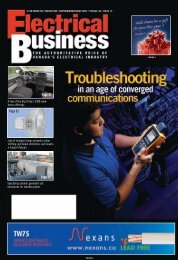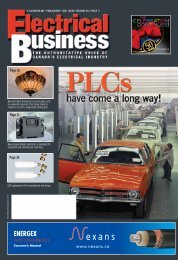Download - Electrical Business Magazine
Download - Electrical Business Magazine
Download - Electrical Business Magazine
Create successful ePaper yourself
Turn your PDF publications into a flip-book with our unique Google optimized e-Paper software.
code fileKris Paszkowiak, P.Eng.Interconnecting solar power systemsEver-increasing electricity bills are causingsome concerned homeowners to considerthe installation of solar panels on theroofs of their homes. Whether motivated bythe impact on their pocketbook or the desireto be greener and, thus, reduce their carbonfootprint, these homeowners are embracingnew ideas for alternative energy generation.Whatever their motivation, their goal wouldultimately benefit all ratepayers by reducingdemand on the provincial power grid.In Ontario, for example, the Ontario PowerAuthority has introduced a Feed-in Tariff(FIT) program for renewable energy projects.One component of that program is somethingcalled ‘microFIT’, which applies to small,renewable power-generating projects of10kW or less. Prices under the microFITprogram range from $0.11/kWh for landfillgas projects to very substantial $0.80/kWh forsolar photovoltaic systems.(More information, including the limits onthe domestic content requirements for PV systems,is available at www.powerauthority.on.ca.)Questions and answers compiled by the <strong>Electrical</strong> Safety Authority VISIT WWW.ESASAFE.COMTackle The CodeConundrum...if you dareAnswers to this month’squestions in May’s<strong>Electrical</strong> <strong>Business</strong>.How did you dowith March’s quiz?Are you a...Master Electrician ? (3 of 3)Journeyman ? (2 of 3)Apprentice ? (1 of 3)Plumber ?! (0 of 3)Question 1Ventilation equipment intended for usewith electrical vehicle supply equipmentshall be permitted to be supplied by thebranch circuit supplying the electric vehiclecharging equipment.a) Trueb) FalseQuestion 2Non-metallic sheathed cable type NMWU shallbe required for all branch circuits of temporarywiring installationsa) Trueb) FalseQuestion 3The station ground electrode shall be connectedto the fence by a tap conductor at each end,corner and gate post, and at intermediate postsat intervals not exceeding ___ m by a conductorof not less than No. 2/0 AWG copper.a) 3 m c) 6 mb) 5 m d) 12 mThe Canadian <strong>Electrical</strong> Code (CEC) has anumber of electrical safety rules that apply to theinstallation of typical micro-generation systems.The applicable rules are spread out acrossvarious sections of the CEC. For example,Section 50 contains specific rules pertaining tothe installation of solar photovoltaic systems,while Section 84 deals with interconnecting theelectric power production sources with thesupply authority system.Also, we need to remember all of the otherapplicable sections, such as Sections 4, 10, 12,14 and 26.The ability to disconnect the photovoltaicsystem is critical; the visible single point ofisolation provides safety for the supplyauthority’s staff, as well as any person whomight be performing any repairs orcomponent replacements. Rule 50-012“Disconnecting means”, requires that adisconnect switch be provided to disconnectall equipment—including the powerconditioningunit—from all ungroundedconductors of all sources. When theAnswers to Code Conundrum<strong>Electrical</strong> <strong>Business</strong> March 2010Q-1: Armoured cable is permitted to befished into a wall cavity containing nonmetallicsheathed cable.b) False. Rule 12-612.Q-2: Where receptacles exposed to theweather are installed in surface-mountedoutlet boxes, the cover plates shall beheld in place by two screws or by someother equivalent means.b) False. Rule 26-702(2) requires thecover plate be held in place by fourscrews, or some other equivalent means.Q-3: The branch circuit supplying acathodic protection system rectifier shallbe permitted to supply additional outlets.b) False. Subrule 80-008 states thebranch circuit shall be provided solely forthe cathodic protection system rectifier.equipment in question is energized from morethan one source, the disconnecting means shallcomply with Rules 14-414 and 14-700.The second critical requirement is the use ofa grid-dependent inverter certified to CSAC22.2 No. 107.1-01 “General Use PowerSupplies”. Where inverters approved for gridinterconnection are used, the anti-islandingfeature will automatically isolate the solarpanels from the supply authority upon loss ofsupply authority voltage. However, varioussupply authorities and inspection authoritiesinsist on enforcing Rules 84-022“Disconnecting means – Supply authoritysystem” and 84-024 “Disconnecting means –General” because they do not want to rely onthe electronics, and because of the concern thateven a small generator can magnetize thedistribution transformer primary, resulting in ahazard to linemen.The installation of even a small solarpoweredsystem can get complicated, andthere’s major cost involved. A typical 3kW to4kW solar panel system can have a price tag ofabout $40,000 to $65,000. Other concerns aretechnical in nature and some are not, such asassessing the solar panels’ exposure to the sun,available roof area and roof integrity, buildingcode requirements, insurance and taximplications, etc.Kris Paszkowiak is principal of CodeSafetyAssociates, a consulting firm serving the needs ofthe electrical industry. He holds a MasterElectrician licence and has served numerousorganizations over the years, including theCanadian Advisory Council on <strong>Electrical</strong> Safety,Committee on CE Code Part I and UL <strong>Electrical</strong>Council. E-mail CodeSafety Associates atkris.paszkowiak@codesafety.ca.Always consultthe electrical inspectionauthority in your province/territory for more specificinterpretations.CSA_EB_Nov09.indd 130 • April 2010 • www.EBMag.com10/26/09 2:36:06 PM

















